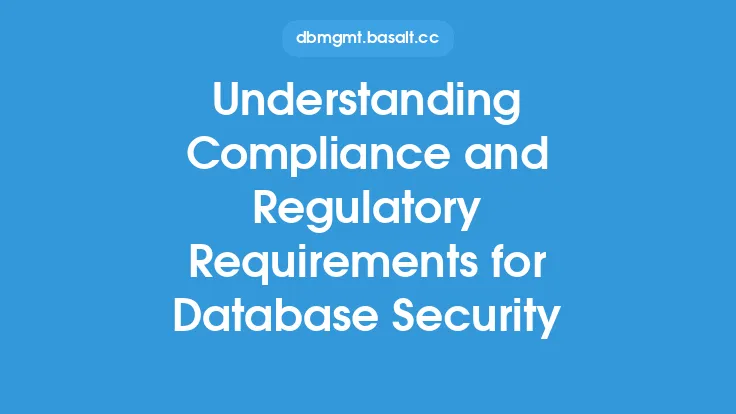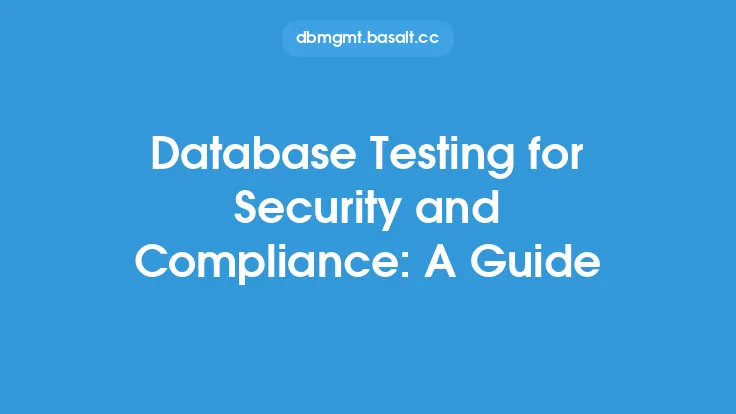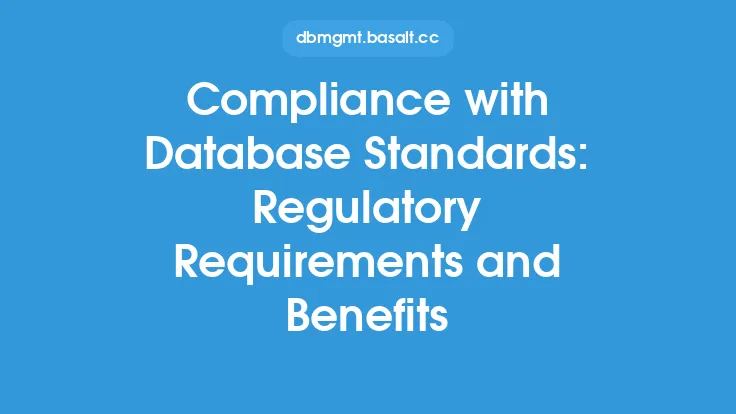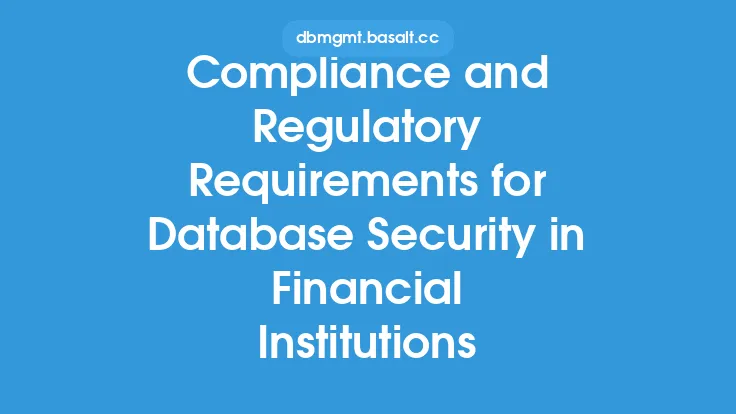As a small or medium-sized business, ensuring the security and compliance of your database is crucial to protect sensitive information and maintain customer trust. Database security compliance involves implementing measures to prevent unauthorized access, use, disclosure, disruption, modification, or destruction of data. In this article, we will provide a comprehensive guide to database security compliance for small and medium-sized businesses, focusing on evergreen information that remains relevant and applicable across various industries and regulatory environments.
Introduction to Database Security Compliance
Database security compliance is an ongoing process that requires continuous monitoring, assessment, and improvement. It involves implementing technical, administrative, and physical controls to ensure the confidentiality, integrity, and availability of data. Small and medium-sized businesses must prioritize database security compliance to avoid reputational damage, financial losses, and legal consequences. A well-planned database security compliance program helps businesses to identify and mitigate potential risks, ensure business continuity, and maintain regulatory compliance.
Understanding Database Security Risks
Database security risks can arise from various sources, including internal and external threats. Common database security risks include unauthorized access, SQL injection attacks, malware, phishing, and denial-of-service (DoS) attacks. Small and medium-sized businesses must identify and assess potential database security risks to implement effective controls and mitigation strategies. This includes conducting regular risk assessments, vulnerability scans, and penetration testing to identify weaknesses and vulnerabilities in the database and its surrounding infrastructure.
Implementing Database Security Controls
Implementing database security controls is essential to prevent unauthorized access and protect sensitive information. Common database security controls include access controls, authentication and authorization, encryption, firewalls, and intrusion detection and prevention systems. Small and medium-sized businesses must implement a layered security approach, which includes multiple controls to prevent, detect, and respond to database security incidents. This includes implementing role-based access controls, multi-factor authentication, and encryption for data at rest and in transit.
Database Security Best Practices
Database security best practices provide a foundation for implementing effective database security controls. Common database security best practices include regularly updating and patching database software, implementing secure configuration and change management, conducting regular backups and disaster recovery, and providing ongoing training and awareness programs for employees. Small and medium-sized businesses must also implement incident response and management plans to quickly respond to and contain database security incidents.
Compliance Frameworks and Standards
Compliance frameworks and standards provide a structured approach to implementing database security controls and ensuring regulatory compliance. Common compliance frameworks and standards include NIST Cybersecurity Framework, ISO 27001, and COBIT. Small and medium-sized businesses must select a compliance framework or standard that aligns with their industry and regulatory requirements. This includes implementing controls and processes to meet specific compliance requirements, such as data encryption, access controls, and incident response.
Ongoing Monitoring and Assessment
Ongoing monitoring and assessment are critical components of a database security compliance program. Small and medium-sized businesses must regularly monitor database activity, assess database security controls, and perform vulnerability scans and penetration testing. This includes implementing continuous monitoring tools and techniques to quickly identify and respond to database security incidents. Ongoing monitoring and assessment help businesses to identify areas for improvement, implement corrective actions, and maintain regulatory compliance.
Incident Response and Management
Incident response and management are essential components of a database security compliance program. Small and medium-sized businesses must implement incident response and management plans to quickly respond to and contain database security incidents. This includes establishing incident response teams, implementing incident response procedures, and conducting regular training and exercises. Incident response and management plans help businesses to minimize the impact of database security incidents, maintain business continuity, and ensure regulatory compliance.
Training and Awareness
Training and awareness are critical components of a database security compliance program. Small and medium-sized businesses must provide ongoing training and awareness programs for employees to educate them on database security best practices, compliance requirements, and incident response procedures. This includes providing regular training sessions, conducting phishing simulations, and promoting a culture of security awareness. Training and awareness help businesses to prevent database security incidents, ensure regulatory compliance, and maintain customer trust.
Conclusion
Database security compliance is an ongoing process that requires continuous monitoring, assessment, and improvement. Small and medium-sized businesses must prioritize database security compliance to protect sensitive information, maintain customer trust, and ensure regulatory compliance. By implementing database security controls, following best practices, and complying with relevant frameworks and standards, businesses can minimize the risk of database security incidents and maintain a strong security posture. Ongoing monitoring and assessment, incident response and management, and training and awareness are critical components of a database security compliance program. By following the guidelines outlined in this article, small and medium-sized businesses can ensure the security and compliance of their databases and maintain a competitive edge in today's fast-paced business environment.





